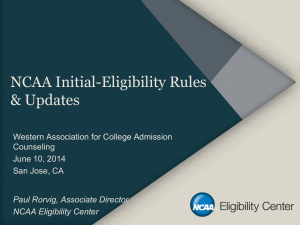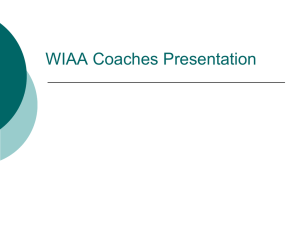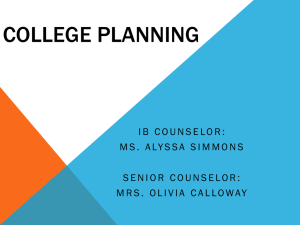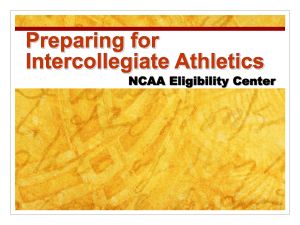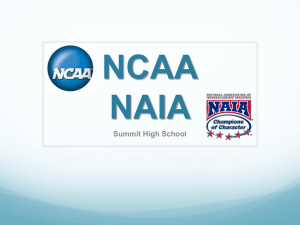Eligibility Center Registration
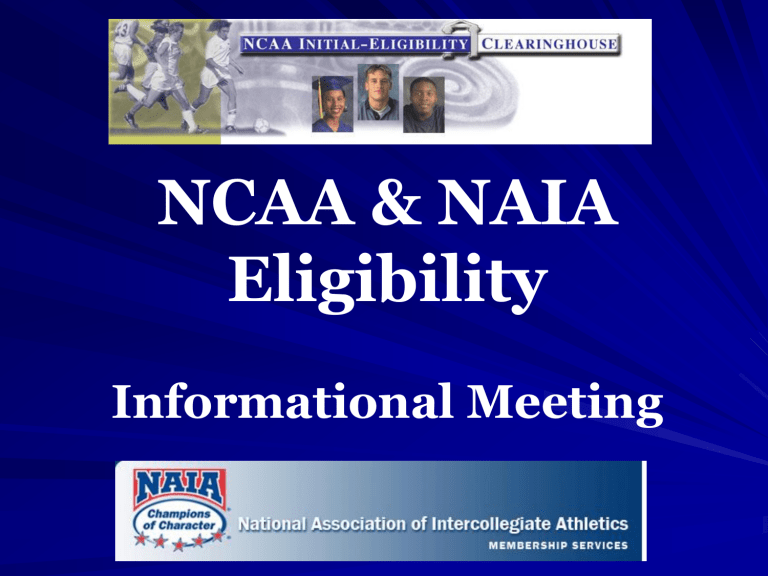
NCAA & NAIA
Eligibility
Informational Meeting
Disclaimer:
This presentation is simply an overview of policies and procedures. Parents should visit websites and read all sections carefully, especially the Guides for Student Athletes, in order to fully understand all academic eligibility requirements.
This presentation will not cover Recruiting rules/policies. Please see the Dean of Students and/or Head Coach for that information.
Information and Resources for College-Bound Student-
Athletes and Parents
VAST number of websites found on
Guidance Website, “N” page http://etown.kyschools.us/EHS_Guidanc e/counselor/NGuide/index.htm
What is the NCAA?
Web Site: www.ncaa.org
1,000 + total schools
–335 schools in Division I
–302 schools in Division II
–447 schools in Division III
What is the NAIA?
National Association of
Intercollegiate Athletics
–300 + Colleges and Universities divided into two Divisions:
Division I
Division II
–Web Site: www.naia.org
Differences between NCAA &
NAIA
Many student athletes automatically think that the NCAA is the only way to go…..
–Perception is based on larger size of
NCAA schools, as a general rule, and the prevalence of large, State universities in the NCAA Division I grouping
Differences between NCAA &
NAIA (con’t)
Generally smaller schools – but the list contains many fine, highly considered, academic institutions
– Not unusual to find schools in the NAIA in the size range between several hundred to several thousand students
– Generally smaller than NCAA Division I and II schools
Can grant athletic scholarships!!!
Differences between NCAA &
NAIA (con’t)
Generally speaking, NAIA institutions:
Are primarily private and/or religious based
Emphasize a liberal arts curriculum
Have enrollments under 2,000 students
Provide for a greater sense of community/belonging
Offer fewer graduate programs
Have higher graduation rates for athletes than NCAA D1 or D2
NAIA Eligibility
Kentucky NAIA schools
Alice Lloyd College, Pippa Passes, Ky.
Asbury College, Wilmore, Ky.
Berea College, Berea, Ky.
Brescia University, Owensboro, Ky.
Campbellsville University, Campbellsville, Ky.
University of the Cumberlands, Williamsburg, Ky.
Georgetown College, Georgetown, Ky.
Lindsey Wilson College, Columbia, Ky.
Mid-Continent University, Mayfield, Ky.
Midway College, Midway, Ky.
Pikeville College, Pikeville, Ky.
Union College, Barbourville, Ky.
Must now register with
NAIA Eligibility Center
Every student who plays in the NAIA for the first time must have their eligibility determined through the
NAIA Eligibility Center.
Visit http://www.playnaia.org/ . Read and follow ALL directions!!!
Register to take the ACT, SAT or both and use the
NAIA Eligibility Center code “9876” as a score recipient.
Pay the $65 fee (or indicate qualification for a fee waiver . Cards accepted: Visa, Mastercard and
Discover.
Registration fee waivers are offered based on need and are available when a student currently qualifies for a waiver of SAT or ACT testing fees or for a free or reduced school lunch program.
Fee waivers for high school students are verified through the student’s high school counselor.
Do not submit a credit card payment if you are eligible to receive a fee waiver. No refunds are issued for credit card payments made prior to receipt of a fee waiver confirmation.
NAIA Eligibility
Minimum eligibility rules for NAIA are
slightly different than those of the NCAA. A high school recruit must satisfy two of the following three conditions to play at the
NAIA level:
1. Achieve either an 18 (Composite) on the
ACT or a 860 on the SAT (CR & Math)
2. A minimum 2.0 grade point average
3. Graduate in the upper half of his/her graduating class
NCAA Eligibility
What is the NCAA Eligibility
Center?
The NCAA Eligibility Center is an organization that works with the NCAA to determine a student’s eligibility for athletics participation in his or her first year of college enrollment.
The center is not the NCAA, but an organization that performs academic
evaluations for the NCAA.
Students who want to participate in college sports during their first year of enrollment in college must register with the center. www.eligibilitycenter.org
Divisions I and II may offer athletic scholarships, while Division III colleges and universities may not.
Eligibility Center
Responsibilities
The NCAA Eligibility Center is responsible for determining the eligibility of every collegebound student-athlete in NCAA Divisions I and
II using the following two areas:
Academic Certification .
– Does the college-bound student-athlete meet the legislated minimum academic requirements?
Amateurism Certification .
– Has the college-bound student-athlete jeopardized his or her amateur status?
Initial-
Eligibility
Overview
Initial-Eligibility Overview:
Academics
Academic initial-eligibility requirements
are different for each of the three divisions.
It is possible for a college-bound studentathlete to be eligible in one division and not another.
Initial-Eligibility Overview:
New Legislation: Core-course time limitation for Division I.
Requirement to graduate with your high school class
You must complete the 16 core-course requirement in eight semesters, which begins when you initially started high school with your ninth-grade class.
If you graduate from high school in eight semesters with your class, you may use one core-course unit completed within one year after graduation (summer or academic year) to meet NCAA Division I initialeligibility requirements.
Initial-Eligibility Overview:
New Legislation:
Requirement to graduate with your high school class
You may complete the core course at a location other than the high school from which you graduated and may initially enroll full time at a college or university at any time after completion of the core course.
Amateurism
Eligibility
Requirements
Amateurism
Eligibility Requirements
If you plan to participate in intercollegiate athletics at an NCAA
Division I or II institution, you must have both your academic and
amateurism status certified by the
Eligibility Center before representing the institution in competition.
Amateurism
Eligibility Requirements
The Eligibility Center encourages you to update your athletics participation information often, especially if you participate in events outside your normal high school season.
•Make sure that you are protecting your amateurism
•Stay college eligible –always ask before you act!
•NCAA amateurism certification Web site: http://www.ncaa.org/wps/portal/ncaahome?WCM_GLOB
AL_CONTEXT=/ncaa/NCAA/Legislation+and+Governance
/Eligibility+and+Recruiting/Eligibility/Amateurism+Certifi cation+Clearinghouse/index .
Steps You Must Take to Participate in NCAA
Division I or II
Athletics
Steps You Must Take:
Freshmen and Sophomores
You can access and print your high school’s
NCAA List of Approved Core Courses at www.eligibilitycenter.org
and clicking
“Resources” , “US Student”, “List of NCAA
Courses”.
The high school “6-digit CEEB/ACT Code” is
180740.
Steps You Must Take:
Juniors Must:
At the beginning of your junior year , log on to the Eligibility Center Web site at www.eligibilitycenter.org
and register.
Register to take the ACT, SAT or both and use the Eligibility Center code “9999” as a score recipient.
Double check to make sure that you are taking courses that match your high school’s
NCAA List of Approved Core Courses.
Steps You Must Take:
Begin your amateurism questionnaire.
Pay the $65 fee.
The Eligibility Center accepts Visa,
MasterCard, Discover and American Express.
If you are a U.S. resident, you can choose to pay by electronic check. Some individuals may qualify to apply for a fee waiver.
Fee Waivers
You are eligible for a waiver of the registration fee only if you have already received a waiver of the SAT or ACT fee.
You must have an authorized high school official submit your fee waiver documentation online after you have completed your registration.
Steps You Must Take:
Request that your high school guidance counselor send an official transcript to the
Eligibility Center after completing your junior year. (The Eligibility Center does NOT accept faxed transcripts.)
Prior to registration for your senior year, check with your guidance counselor and the
Eligibility Center to determine the number of core courses that need to be completed your senior year.
Steps You Must Take:
Seniors Must:
You may take the SAT and/or ACT as often as you feel necessary. The Eligibility Center will use the best scores from each section of the SAT or ACT to determine your best cumulative score.
Check to make sure that you are taking courses that match your high school’s NCAA List of Approved
Core Courses.
Review your amateurism questionnaire responses and request final amateurism certification beginning April 1 (for fall enrollees) or October 1
(for spring enrollees).
Steps You Must Take:
Continue to earn the best grades possible.
Graduate on time (in eight academic semesters).
After graduation, ask your high school guidance counselor to send your final transcript to the Eligibility Center with proof of graduation.
Core Courses,
GPA, Test Scores
Core Courses
• Not all classes you take to meet high school graduation requirements may be used as core courses. Be aware of this when registering.
•Out of state transfer students – Must have original transcripts from all schools.
• Check the high school’s list of approved core courses (48-H).
Grade-Point Average
• Not all classes you take to meet high school graduation requirements will be used in calculating your “Core GPA”.
• ALL grades are used for NAIA (no “core”).
• The best grades from your NCAA core courses will be used when possible. All 4 years of English must be used.
• Grades from additional core courses you took will be used only if they improve your grade-point average.
Grade-Point Average
The eligibility center will assign the following values to each letter grade:
A – 4 points
B – 3 points
C – 2 points
D – 1 point
Therefore, your NCAA Core GPA will be lower than your EHS GPA.
ACT and SAT Tests
You must achieve the required score on an
SAT or ACT test before your full-time college enrollment. (last test dates are in June).
The Eligibility Center only accepts scores from the SAT or ACT testing agency. Test scores submitted from high schools will not be used.
Save yourself time and money when registering, use Code 9999 so that your scores will be sent directly to NCAA Eligibility Center.
ACT and SAT Tests
• If you’ve already taken a test and didn’t send scores, contact Eligibility
Center or go online www.actstudent.org
to send additional score report ($10 fee).
• The writing component of the ACT or
SAT will not be used to determine qualifier status.
DIVISION I
Requirements
KY Division I Schools
University of Kentucky
University of Louisville
Eastern Kentucky University
Morehead State University
Murray State University
Western Kentucky University
Complete listing of D 1 schools: http://web1.ncaa.org/onlineDir/exec/divisionListing
Academic
Eligibility Requirements
Division I
In order to practice, compete and receive institutional financial aid as a freshman, a student-athlete must:
•Graduate from high school;
•Earn a minimum required grade-point average (GPA)
(at least a 2.0) in 16 approved core courses; and
•Earn a combined SAT or ACT sum score that matches the core-course GPA (refer to the “sliding scale” in the
NCAA Guide for the College-Bound Student-Athlete).
16 Core Courses:
- 4 years of English
- 3 years of math (algebra 1 or higher)
- 2 years of natural or physical science
(including one year of lab science if offered by your high school)
- 1 extra year of English, math or natural or physical science
- 2 years of social science
- 4 years of extra core courses (from any category above or foreign language);
GPA & Test Score
Sliding Scale
EHS Graduation Requirements provide:
4 years of English
4 years of Math (Adv Topics doesn’t count)
3 years of Science
3 years of Social Science
13 or 14 total credits of the 16 required by
NCAA
Therefore, students must choose 2-3 additional courses as electives to fulfill
NCAA requirements.
Must choose 2-3 of the following:
• Foreign Language (Spanish or French – each year
counts as one credit)
• Drama (not always offered)
• Journalism
• American Government/KY Studies (not always offered)
• Psychology (not always offered)
• Criminal Justice
• College Algebra
• Pre-Calculus
• AP Calculus
• Anatomy & Physiology
• Physics
• AP Chemistry
**KVHS AP & ECTC Courses – are not automatically approved. They are considered on a “case by case” basis.
GPA & Test Score
Sliding Scale
If a student takes the ACT or SAT more than once, he/she may use the best subscore from different tests to meet the minimum testscore requirements for NCAA.
NAIA – 18 composite must be from one test sitting
Example :
SAT Test
Math
SAT
(10/03)
SAT (12/03)
Scores used
350
420
420
Verbal/
Critical
Reading
470
440
470
Total Score
820
860
890
GPA & Test Score
Sliding Scale
Example: A student takes the ACT and earns the following sub-scores:
English = 16
Math = 20
Reading = 17
Science Reasoning = 15
His sum score is 16 + 20 + 17 + 15 = 68
Based on the sliding scale, his core GPA must be at least a 2.500.
Sliding Scale
Qualifier vs. Non-Qualifier
You will be a qualifier if you meet the academic requirements listed previously. As a qualifier, you:
• Can practice or compete for your college or university during your first year of college;
• Can receive an athletics scholarship during your first year of college; and
• Can play four seasons in your sport as long as you maintain your eligibility from year to year.
Qualifier vs. Non-Qualifier
You will be a nonqualifier if you do not meet the academic requirements listed above. As a nonqualifier, you:
• Cannot practice or compete for your college or university or receive an athletics scholarship during your first year of college;
• Can play only three seasons in your sport as long as you maintain your eligibility from year to year (to earn a fourth season you must complete at least 80 percent of your degree before beginning your fifth year of college).
DIVISION II
Requirements
KY Division II Schools
Bellarmine
Kentucky State
Kentucky Wesleyan
Northern Kentucky
Complete listing of D2 schools: http://web1.ncaa.org/onlineDir/exec/divisionListing
Academic
Eligibility Requirements
Division II
In order to practice, compete and receive institutional financial aid as a freshman, a studentathlete must:
•Graduate from high school;
•Earn at least a 2.0 GPA in 14 approved core courses
( after August 1, 2013 16 core courses ); and
•Earn a combined SAT score of at least 820 (critical reading and math) or an ACT sum score of at least
68.
14 Core Courses (prior to Aug 1, 2013):
• 3 years English
• 2 years math (Algebra I or higher)
•2 years natural/physical science ( 1 year of lab if offered by high school)
• 2 years additional English, math or natural/physical science
•3 years 2013 and after
•2 years social science
• 3 years additional courses (from any area above, foreign language or non-doctrinal religion/philosophy)
• 4 years 2013 and after
Academic
Eligibility Requirements
Division II
• No sliding scale for Division II.
* Beginning August 1, 2013, students planning to attend an NCAA Division II institution will be required to complete
16 core courses .
Qualifier, Partial, &
Non-Qualifier
Qualifier status is the same as that for Division I.
You will be a partial qualifier if you do not meet all of the academic requirements listed for Division II but you have graduated from high school and meet one of the following:
• The combined SAT score of 820 or ACT sum score of
68; OR
• Completion of the 14 core courses with a 2.000 corecourse grade-point average.
As a partial qualifier, you:
• Can practice with your team at its home facility during your first year of college;
• Can receive an athletics scholarship during your first year of college;
• Cannot compete during your first year of college; and
• Can play four seasons in your sport as long as you maintain your eligibility from year to year.
You will be a nonqualifier if you did not graduate from high school, or, if you graduated and are missing both the core-course GPA and the required
ACT or SAT scores.
As a nonqualifier, you:
• Cannot practice or compete for your college or university during your first year of college;
• Cannot receive an athletics scholarship during your first year of college, although you may receive needbased financial aid; and
• Can play four seasons in your sport as long as you maintain your eligibility from year to year.
DIVISION
III
KY Division III Schools
Centre College
Spalding University
Transylvania University
Thomas More College
Complete listing of D 3 schools: http://web1.ncaa.org/onlineDir/exec/divisionListing
Academic
Eligibility Requirements
Division III
Unlike Divisions I and II, there is no uniform set of eligibility requirements for
Division III schools. Therefore, registration with the Eligibility Center is not required .
•Eligibility for admission, financial aid, practice and competition is determined by the institution.
Registration
Eligibility Center Registration
Students who plan to play Division I or II athletics in college need to register with the
Eligibility Center after they complete their junior year in high school.
You must be registered and pay the fee before you can take an Official Visit.
Any student entering college must register online at www.eligibilitycenter.org
.
Eligibility Center Registration
•Select the “New Account” button at the top right of the screen or the cell phone on the left side of the screen.
•Complete the registration.
Eligibility Center Registration
Students will click here to create or log into their account.
Filling out the Worksheet
• The worksheet is provided to assist in monitoring the progress in meeting NCAA initial-eligibility standards. The Eligibility Center will determine the official status after graduation.
• Remember to check the high school’s list of approved courses (Form 48-H) for the classes taken.
• Use the following scale:
A = 4 quality points; B = 3 quality points; C = 2 quality points; D = 1 quality points
Use NCAA
Worksheet
Examples.
Students With Disabilities
A student with a disability must meet the same requirements as all other students but is provided certain accommodations to help meet these requirements.
Students with a diagnosed disability only need to let the NCAA know about their disability if they plan on using core courses after their eighth semester of high school and they plan on attending a Division I college.
See website for more information.
Registration – Transcripts
A preliminary transcript is sent when you register.
You must ask the Guidance Office to send this transcript once you have registered.
A final transcript is sent after graduation. You must also ask the Guidance Office to send this transcript.
Final transcripts can not be changed, therefore, you should come in and double check for errors.
We will mail Final Transcripts the Friday following Graduation!!
PIN Number
After you submit the Registration form you may check the status of your file:
1)by phone or
2)by visiting the website
Either way – you will need a Personal
Identification Number (PIN) to access your account.
Check Your Status
After you have registered, paid the fee and had your transcript and SAT or ACT score(s) sent, you may check your status by:
1) Phone – Eligibility Center Customer Service toll free – 1-877-622-2321
8 a.m. to 5 p.m. Central time M - F.
2) Internet
When Does a Student Receive a
Preliminary Report?
The Eligibility Center prioritizes incoming information by the following categories:
•Students who are being actively recruited by an institution and are on an institutional request
list (IRL)
•Students with disabilities who have taken a nonstandard test or who have registered with NCAA disability services
•Students who request a report. You can call or send an email to request.
Remember, meeting the NCAA academic rules does not guarantee your admission into a college.
You must still apply for admission.
Recruiting
Specific information about recruiting policies can be found in Guide for the
College-Bound Student-Athlete.
Financial Aid
•There are no four-year athletics scholarships.
•All athletics scholarships awarded by NCAA institutions are limited to one year and are renewable each academic year and may be reduced or withdrawn.
•Athletics scholarships may be renewed each academic year for a maximum of five years within a six-year period of continuous college attendance.
•Athletics scholarships are awarded in a variety of amounts, ranging from full scholarships (including tuition fees, room, board and books) to partial scholarships (e.g., books only).
Questions???
Questions???
The Eligibility Center has created a high school direct phone line. Please contact the Eligibility Center with your questions at 877/622-2321.
Questions
1.
Q: If I transferred from another school, how are my “Core Courses” defined?
A: You will use the List of Approved
Courses and Grading scale from each school attended in calculating “Core
GPA”. You will need original transcripts from each school, also.
Questions
2.
Q: If I am taking a class at ECTC, does it count toward my “Core
GPA?”
A: Yes, if it is in the area of English,
Math, Science, or Social Science. You will need to provide the NCAA with your
ECTC Transcript in addition to the EHS transcript.
Questions
3.
Q: If I am taking a class through
Kentucky Virtual High School
(KVHS), does it count toward my
“Core GPA”?
A: More than likely, if it is in the area of
English, Math, Science, or Social Science.
The NCAA approves classes taken “by non-traditional means” on a case-by-case basis. However, they have researched
KVHS and have approved those courses in the past.
Questions
4.
Q: On the registration form it asks for my email address. What if I don’t have email?
A: All students have free email accounts through EHS. However, you could simply leave that part blank and indicate, where asked, that you prefer the paper option for all correspondence.
Questions
5.
Q: I took Algebra 1 in the 8 th grade.
Does it count as a Core Course for me?
A: NO – only courses taken in the 9 th grade and beyond count as “Core”, even if listed on the high school transcript.
Resources
Go to www.eligibilitycenter.org
From the home page, click on “Resources.”
The “Resources” page has a link to the
“Guide for the College-
Bound Student-
Athlete”, as well as other helpful information.
You will need Acrobat
Reader to view the
Guide.
Also found on
Guidance website.
